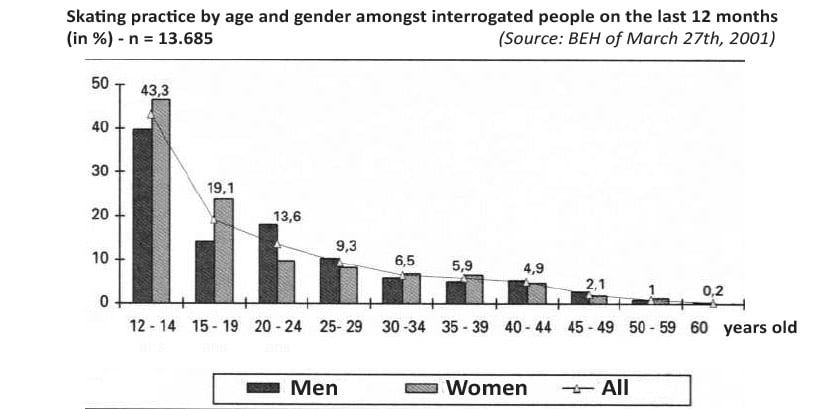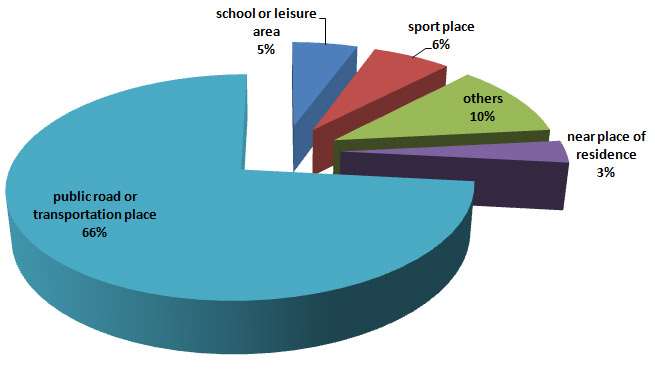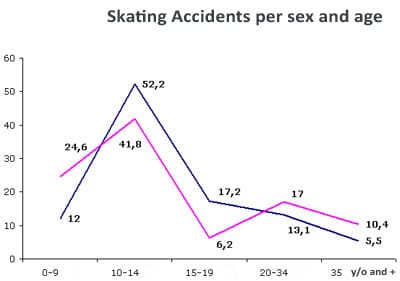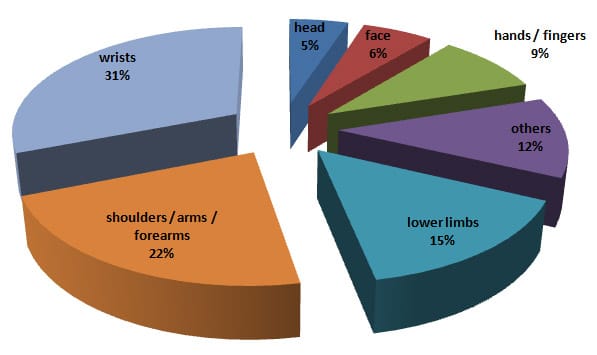Statistics of Skating Accidents
If skating is not especially more dangerous than any other sport, looking into skating accidents remains interesting. Traumatologic studies show that wrists are the most exposed parts of the body in case of a fall, but what about the others? Let's scan injuries…
Par alfathor

Few epidemiological studies on skating

With the increase of the number of skaters by the end of the 90’s and the early 2000’s, the number of accidents has also considerably increased. The skaters do not take more risks than before, but the skating population has just considerably grown. There would be more than a 100 millions of skaters in the world, and around 2 millions in France. Several dozens of thousands of skaters resort to the casualty department each year.
 The phenomenon caught the eye of the ministry and of the healthcare supervision institute who published a survey on the practice of skating and helmet wearing on March 27th, 2001 in the BEH, the French weekly epidemiological report. The statistics relate to the 1997-1999 period but have probably not evolved much since then.
The phenomenon caught the eye of the ministry and of the healthcare supervision institute who published a survey on the practice of skating and helmet wearing on March 27th, 2001 in the BEH, the French weekly epidemiological report. The statistics relate to the 1997-1999 period but have probably not evolved much since then.
Practice and gender: Women are the majority!
Women seem to practice a bit more than men (55.1% v. 44.9%) but there are differences according to age. Between 20 and 29 or between 45 and 49, men are more numerous. Let’s note that most of the skaters are between 12 and 19 years old, that is to say teenagers.
Almost one youth going to school out of four has done skating during the 12 months preceding the survey.
Days and hours of scratches
Most accidents happen on Sundays. The most probable explanation is that Sunday is the perfect day for leisure activities, especially for children. Let’s also note a peak of accidents on Wednesdays, probably due to the same cause. A lot of accidents happen between 2 and 7 PM.
The cause of accidents: falling!
 Almost 91% of the accidents are due to a fall, especially amongst the youngest whatever their gender. Collisions are only 4.1% of the accidents. The two-thirds of the time, they happen on public places and road or transportation places.
Almost 91% of the accidents are due to a fall, especially amongst the youngest whatever their gender. Collisions are only 4.1% of the accidents. The two-thirds of the time, they happen on public places and road or transportation places.
Places of practice and skaters’ assessment
Accidents near the place of residence represent only 13.4% of the cases, sport places 5.5% and school or leisure areas 4.5%.
The two-thirds of the time, leisure practice is mentioned against only 5.1% of sport practice. Let’s say that mastering the practice of skating is a limiting factor for accidents.
Distribution of skating accidents by age and gender
Generally speaking, women are less concerned than men, except before the age of 10 and after 20.
Whether girl or boy, there are more accidents between the ages of 10 and 14. If you are a parent, these figures may encourage you to check if your children wear pads (including a helmet).
If the number of accidents decreases for boys over 15, there is a recrudescence for women from the same age and until 35. Maybe ladies do not find protective pads suiting enough…?
The most exposed areas: upper limbs
By experience, you quickly realize that the upper limbs are the most exposed in case of a fall. Most of the time, you have the reflex to stretch your arms to hold yourself or soften the impact.
Upper limbs: wrist victorious
 The upper limbs are made of:
The upper limbs are made of:
- the wrists
- the shoulders
- the arms
- the forearms
- the hands
- the fingers
Distribution of injuries >
They represent almost the two thirds of the upper limbs’ injuries (61.7%). More than half of the accidents on shoulders are fractures.
Wrists alone are almost the third (31%) of injuries happening during practice, hence the importance of protecting yourself!
Doctors have to treat a fracture almost one time out of two, and a contusion one-third of the time. Dislocations and sprains are less that a fifth of the cases.
Shoulders, arms and forearms are quite exposed with children who tend to stretch them forward in case of a fall. It often ends up with fractures. Wearing wrist guards may seriously reduce the risks.
Whatever your age group, wrists are the most exposed body parts. Choosing fitting wrist guards is essential. Check out our article in the « health » section.
Lower limbs: a lot of contusions
The lower limbs are made of:
- the legs
- the knees
- the ankles
- the feet
They represent « only » 15.1% of the injuries. 4 times out of 10, the skater will suffer from a contusion, and 1 time out of 4 from dislocation or sprain. Fractures happen in 15 cases out of 100 when the lower limbs are involved.
The number of injuries at the lower limbs increases with age. After the age of 24, they are a bit more than 24% of injuries. In one-third of the cases, it is about dislocation or sprains.
The head: not much involved but not to be neglected
 Injuries of the face and the head are still almost 11% of the listed lesions. Do not neglect to wear helmets.
Injuries of the face and the head are still almost 11% of the listed lesions. Do not neglect to wear helmets.
Head lesions are about contusions 7 times out of 10, and open wounds 2.5 times out of 10. Fractures happen 3 times out of 100 if the head is involved… Which is not that frequent but can turn out to be far more serious than a wrist fracture for example.
Under the age of 10, accidents to the head and face are more frequent. It is essentially contusions or open wounds. One may venture that children’s motor function is less developed, but also that their head is proportionally heavier compared to their size and thus harder to control…
Conclusion
Generally speaking, boys hurt themselves more seriously than girls. Most serious accidents mostly happen between 0 and 14. Let’s put things into perspective though: regular sportspeople are less hospitalized than leisure skaters, which is proof that a regular practice reduces the risks of serious lesions. Wearing a helmet is not a luxury, especially if you are a beginner. Learning skating should be progressive and as far as possible with a quality supervision. Controlling your skates is as important as wearing pads. Do not hesitate to take lessons with a certificated instructor or in a club in order to acquire good reflexes.
Liens utiles
Epidemiological Bulletin about skating and helmet (2,84 Mo – format pdf)
How to choose and use your helmet
How to chooe your wristguards
Translation: Chloé Seyres
Photos: ReL & all rights reserved

Mero
25 novembre 2014 at 13 h 21 min